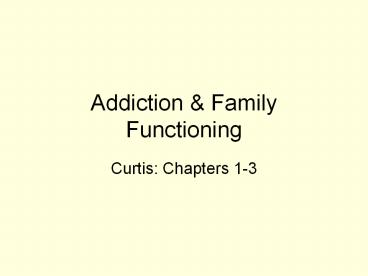Addiction - PowerPoint PPT Presentation
1 / 22
Title:
Addiction
Description:
Most families believed that once drinking stopped, ... 4 types of wives: Suffering Susan low self esteem; mistreatment by alcoholic husband confirms self ... – PowerPoint PPT presentation
Number of Views:404
Avg rating:3.0/5.0
Title: Addiction
1
Addiction FamilyFunctioning
- Curtis Chapters 1-3
2
- Prior to 1950s, family problems kept secret
- Most families believed that once drinking
stopped, family problems would disappear - Therapists recognized that many treated
alcoholics not success in recovery - During 1950s, treatment focused mainly on wife
3
Whalen (1953) Wife chooses alcoholic
- 4 types of wives
- Suffering Susan ? low self esteem mistreatment
by alcoholic husband confirms self image - Controlling Catherine ? husbands drinking gives
her something to control - Wavering Winnifred ? high dependency needs as
long as he drinks, he will continue to need her - Punishing Polly ? envious resentful of men
belittles husband constantly, so he will continue
to drink (this increases his vulnerability)
4
Criticism
- Not representative sample
- Does not consider progressive nature of
alcoholism - Does not consider possibility that relationship
changes as alcoholism progresses - Further stigmatizes alcoholism
5
Jackson (1954)
- wife goes through stages of adjustment to
husbands drinking - Stage 1 husbands drinking causes tension
embarrassment. Denies problem to avoid facing
it. - Stage 2 becomes more socially isolated to cover
up husbands drinking. Drinking now a focal
point so conflict increases. Wife develops
self-pity. Husband resents her attempts to
control his drinking
6
- Stage 3 kids begin to have problems sexual
intimacy fades violence becomes frequent.
Family members begin to feel helpless. Wife may
seek outside help but then feels guilty for being
unable to cope. - Stage 4 wife assumes responsibility for family
functioning may gain new self-confidence
children begin to experience fewer problems and
family stabilizes
7
- Stage 5 wife kids leave alcoholic husband
- Stage 6 mother kids establish themselves
without alcoholic husband - Stage 7 if he remains sober, husband returns to
family, but has difficulty re-establishing adult
role within family. - Criticism does not consider differences in
family adjustment fails to consider treatment
efforts does not address cycle of abuse/hope
8
1960s
- Through 1960s, research noted that alcoholics
whose wives also in treatment - Stayed in treatment longer
- Had significantly improved recovery
- Felt major improvement in marital harmony
9
- Bateson (1960) ? family works as unit to maintain
homeostasis (balance). Family members unable to
adjust to non-drinking - Ewing Fox (1968) ? alcoholism is a family
disorder. Family members need to be aware of how
interaction patterns might have contributed to
familys dysfunction
10
Theoretical Approaches toFamily Treatment (Ch. 2)
- Dulfano ? views family as system
- Any change in role of one member also changes
other members in order to maintain homeostasis - Non-drinking threatens family environment as much
as drinking does - Alcohol abuse distorts family relationships
- Therapist holds alcoholic responsible for own
behaviour and focuses on communication patterns
11
Theoretical Approaches contd
- Kaufman ? 4 different types of alcoholic
families, each needing different interventions - Functional Family System ? Alcoholic drinks due
to problems outside of the family. Members seem
happy and stable little conflict. Not likely to
present for treatment
12
2. Neurontic, Enmeshed Family System
- Normal family functioning disrupted
- Members feel guilty and responsible for alcoholic
- Members try to take care of each other, while
alcoholic becomes more isolated - Verbal abuse by alcoholic common
- Treatment involves encouraging members to become
involved with support groups
13
3. Disintegrate Family System
- Alcoholic frequently absent from family
- Reasonable family interactions broken down
- Treatment begins with alcoholic
- Once sobriety achieved, focus on re-defining
family roles and re-establishing communication
14
4. Absent Family System
- Alcoholics behaviour now results in complete
separation from family reconciliation unlikely - Treatment directed toward establishing new social
networks
15
Family Therapeutic Theories(Ch. 3)
- Whitakeer ? Symbolic Theory
- Bandura ? Social Learning Theory
- Satir ? Process Model
16
Symbolic Theory(Whitaker)
- Healthy family ? functions to uphold unity and
promote growth - Unhealthy family ? limited sense of unity rules
and roles inflexible expression of individual
differences not possible - Central beliefs ? Family members need to switch
roles to experience what others in family
experience - Goal of treatment ? increase creative problem
solving skills
17
Social Learning Theory(Bandura)
- Inappropriate behaviour is learned during
childhood through modelling - Central beliefs behaviour is maintained through
reinforcements - Goal of Treatment behavioural modification and
healthy learning environment
18
Process Model(Satir)
- Family system is balanced each member pays a
price to keep it that way - Central Beliefs dysfunction leads to low
self-esteem prevents appropriate communication - Goal of Treatment using sculpting to move
family from state of dysfunction - 4 types of individuals with dysfunctional
communication styles
19
1. Placater
- Cannot express anger or displeasure
- Pattern of avoidance
- Self-worth based on acceptance by others
20
2. Blamer
- Critical, judgmental shaming
- Deflects from facing own issues and meeting
responsibilities
21
3. Intellectualizer
- Tries to analyze and fix others
- Feels vulnerable if own feelings exposed
- Wants to make sense of problems
22
4. Distracter
- Attempts to protect self and others from pain
(i.e. charmer or clown) - May use drugs and alcohol to avoid problems































